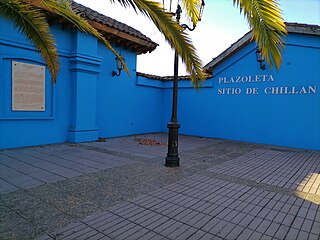
Bernardo O'Higgins Riquelme was a Chilean independence leader who freed Chile from Spanish rule in the Chilean War of Independence. He was a wealthy landowner of Basque-Spanish and Irish ancestry. Although he was the second Supreme Director of Chile (1817–1823), he is considered one of Chile's founding fathers, as he was the first holder of this title to head a fully independent Chilean state.

José Francisco de San Martín y Matorras, nicknamed "the Liberator of Argentina, Chile and Peru", was an Argentine general and the primary leader of the southern and central parts of South America's successful struggle for independence from the Spanish Empire who served as the Protector of Peru. Born in Yapeyú, Corrientes, in modern-day Argentina, he left the Viceroyalty of the Río de la Plata at the early age of seven to study in Málaga, Spain.

The Argentine War of Independence was a secessionist civil war fought from 1810 to 1818 by Argentine patriotic forces under Manuel Belgrano, Juan José Castelli, Martin Miguel de Guemes and José de San Martín against royalist forces loyal to the Spanish crown. On July 9, 1816, an assembly met in San Miguel de Tucumán, declaring independence with provisions for a national constitution.

The Battle of Maipú was fought near Santiago, Chile on 5 April 1818, between South American rebels and Spanish royalists, during the Chilean War of Independence. The Patriot rebels led by Argentine general José de San Martín effectively destroyed the Spanish forces commanded by General Mariano Osorio, and completed the independence of the core area of Chile from Spanish domination.

The Battle of San Lorenzo was fought on 3 February 1813 in San Lorenzo, Argentina, then part of the United Provinces of the Río de la Plata. The royalist troops were composed of militiamen recruited in Montevideo under the command of militia captain Antonio Zabala, who were defeated by the Regiment of Mounted Grenadiers under the command of José de San Martín. This battle was the baptism by fire for this military unit, as well as for San Martín in the Spanish American wars of independence.

The Battle of Cancha Rayada, was fought in Chile between South American patriots and Spanish royalists, during the Osorio's campaign in the South American wars of independence. The result was a defeat for the patriot forces, weeks later the patriots take their rematch at the Battle of Maipú.

The Chilean War of Independence was a military and political event that allowed the emancipation of Chile from the Spanish Monarchy, ending the colonial period and initiating the formation of an independent republic.

Colonel Luis Florentino Juan Manuel Silvestre de los Dolores de la Carrera y Verdugo was a Chilean military officer who fought in the Chilean War of Independence. Together with his brothers José Miguel and Juan José, they were some of most important leaders of Chilean struggle for independence during the period of the Patria Vieja. The Carrera family is of Basque origin.

Brigadier José Antonio de Pareja y Mariscal was a Spanish Navy officer. He captained the Argonauta during the Battle of Trafalgar in 1805 and in 1812 commanded Royalist troops during the Chilean War of Independence.
Treaty of Lircay was a truce treaty agreed between the Royalist and the Patriot forces during the Chilean War of Independence.

Events from the year 1814 in Chile
Marshal Pedro Andrés del Alcázar y Rodríguez de Zapata was a Spanish and later Chilean Army officer and hero of the Chilean War of Independence.
The Battle of Les Tres Acequias, fought during the Chilean War of Independence, occurred near San Bernardo on 26 August 1814. The confrontation occurred between the two factions of Carrera and Bernardo O'Higgins, resulting in a defeat for O'Higgins that would in turn lead on to the defeat of the nationalists by the royalist forces at the battle of Rancagua a month later.

The Battle of El Roble was fought on the Itata river, 17 October 1813, between the Chilean patriot general José Miguel Carrera and Spanish royalist forces under the command of Clemente Lantaño and Luis Urrejola. The surprise patriot victory at El Roble as a result of Bernardo O'Higgins' actions at the end of the day was to result in a change of patriot commander, and a severe split within the patriot movement.

The siege of Chillán occurred from July 27th to August 10th, 1813, as patriot forces attempted to dislodge a determined band of royalist defenders. The failure of José Miguel Carrera to take the city would contribute to his removal from office by the junta later in the campaign.
The battle of Membrillar occurred on 20 March 1814, during the War of Chilean Independence.
The Battle of El Quilo, fought during the Chilean War of Independence, occurred at el Quilo, on the southern side of the Itata river, on 19 March 1814.
The Battle of Curapalihue fought in Chile, was a minor encounter between South American rebels and Spanish royalists, during the South American wars of independence. The result was a defeat for the royalists.
The following lists events that happened during 1813 in Chile.

Juan José Pedro de la Carrera y Verdugo or Juan José Pedro Carrera was a Chilean soldier and patriot who actively participated in the first phase of the Chilean War of Independence, a stage known as the Patria Vieja. In support for his brother José Miguel Carrera, and together with his younger brother Luis and other Republican officers, he formed one of the main factions within the supporters of Independence: the Carrerino group. He was shot to death in Mendoza together with his brother Luis, at the hands of the city authorities.












